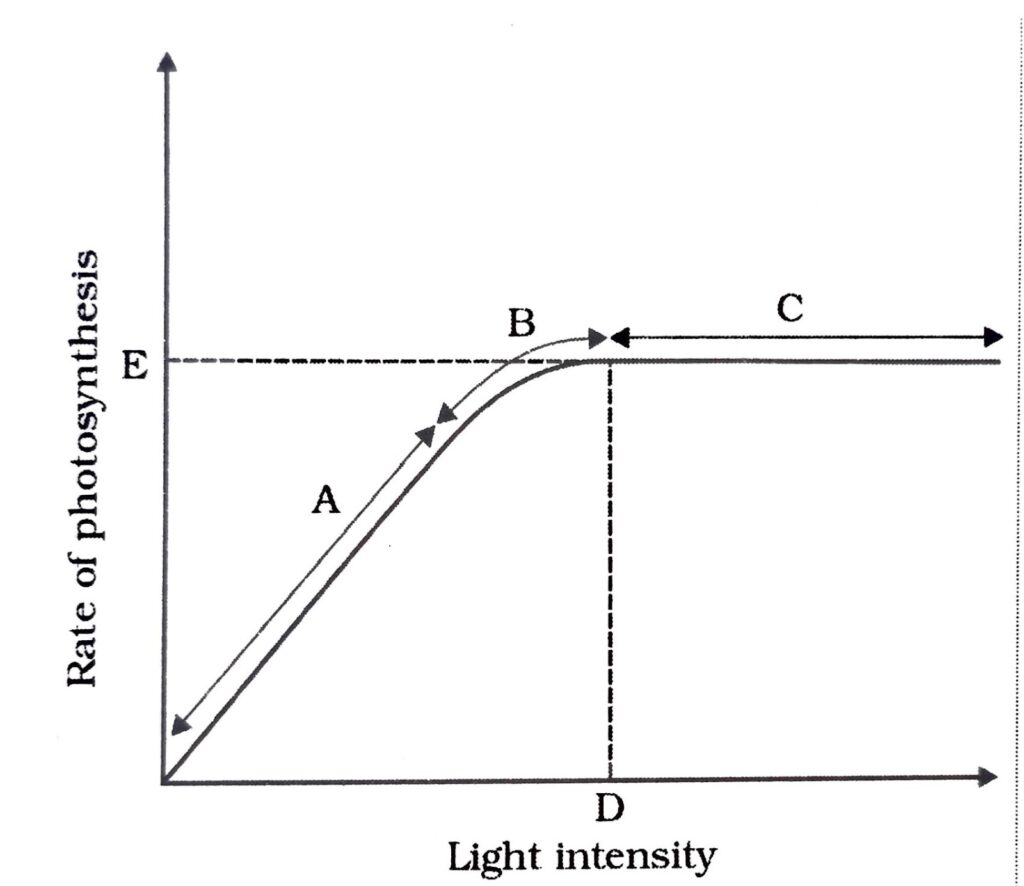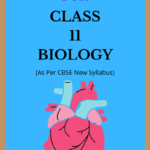NCERT Class 11 Biology Chapter 13 Photosynthesis in Plants Solutions to each chapter is provided in the list so that you can easily browse through different chapters NCERT Class 11 Biology Chapter 13 Photosynthesis in Plants and select need one. NCERT Class 11 Biology Chapter 13 Photosynthesis in Plants Question Answers Download PDF. NCERT Biology Class 11 Solutions.
NCERT Class 11 Biology Chapter 13 Photosynthesis in Plants
Also, you can read the NCERT book online in these sections Solutions by Expert Teachers as per Central Board of Secondary Education (CBSE) Book guidelines. CBSE Class 11 Biology Solutions are part of All Subject Solutions. Here we have given NCERT Class 11 Biology Chapter 13 Photosynthesis in Plants Notes, NCERT Class 11 Biology Textbook for All Chapters, You can practice these here.
Photosynthesis in Plants
Chapter: 13
BIOLOGY
TEXTUAL QUESTIONS ANSWERS
Q.1. By looking at a plant externally can you tell whether a plant is C3 or C4? Why and how?
Ans. No, one can not tell whether a plant is C3 or C4 by looking externally at a plant. Internal anatomy/Kranz anatomy of leaves tells.
Q.2. By looking at which internal structure of a plant can you tell whether a plant is C3 or C4? Explain.
Ans. The leaves of C4 plants have Kranz anatomy-
(i) Vascular bundles are surrounded by bundle sheath cells arranged in layers [wreath like manner].
(ii) Bundle sheath cells have prominent chloroplasts and thick walls.
(iii) These plants show two types of photosynthetic cells – mesophyll cells and bundle sheath cells.
(iv) Chloroplasts are dimorphic i.e.granal in mesophyll cells and agranal in bundle sheath Cells.
Q.3. Even though a very few cells in a C4 plant carry out the biosynthetic – Calvin pathway, yet they are highly productive. Can you discuss why?
Ans. C4 plants are highly productive because photorespiration is absent in C 4 plants due to high CO₂ concentration and absence of O₂ in bundle sheath cells. 2
Q.4. RuBisCo is an enzyme that acts both as a carboxylase and oxygenase. Why do you think RuBisCo carries out more carboxylation in C4 plants?
Ans. RuBisCocarries out more carboxylation in C4 plants due to high CO₂ conc and absence of O₂ in bundle sheath cells of 2 C 4 plants.
Q.5. Suppose there were plants that had a high concentration of Chlorophyll-b, but lacked chlorophyll-a, would it carry out photosynthesis? Then why do plants have chlorophyll-b and other accessory pigments?
Ans. Plants that had a high concentration of Chlorophyll-b but lacked chlorophyll-a would not carry out photosynthesis because reaction centre is formed by chlorophyll a. Chlorophyll b, Xanthophylls, Carotenoids are accessory pigments because:
(i) They absorb light and transfer energy to Chlorophyll a.
(ii) They protect Chlorophyll a from photo oxidation.
Q.6. Why is the colour of a leaf kept in the dark frequently yellow, or pale green? Whichpigment do you think is more stable?
Ans. Leaf becomes yellow or pale green because chlorophyll degrades and there is no formation of chlorophyll in dark. Carotenoids are more stable pigment.
Q.7. Look at leaves of the same plant on the shady side and compare it with the leaves on the sunny side. Or, compare the potted plants kept in the sunlight with those in the shade. Which of them has leaves that are darker green? Why?
Ans. Leaves of plants in shaded side are dark green because they develop more chlorophyll to trap enough light for photosynthesis.
Q.8. Figure 13.10 shows the effect of light on the rate of photosynthesis. Based on the graph, answer the following questions:
(a) At which point/s (A, B or C) in the curve is light a limiting factor?
(b) What could be the limiting factor/s in region A?
(c) What do C and D represent on the curve?

Ans. (a) Light is a limiting factor in the region A and B.
(b) Light is a limiting factor in region A.
(c) C is the region where rate of photosynthesis does not increase with the increase in light intensity. Point D represents the optimum point and rate of photosynthesis remains constant after this point.
Q.9. Give comparison between the following:
(a) C3 and C4 pathways.
Ans. C3 and C4 pathways
CALVIN CYCLE (C3 Cycle) —
(a) It occurs in all photosynthetic plants.
(b) Calvin cycle has three phases: Carboxylation, Reduction and Regeneration of RuBP
(c) Carboxylation:
(i) Ribulose 1, 5-bisphosphate / Ru BP combines with CO₂ to form two molecules of three carbon compound called 3-phosphoglyceric acid [PGA].
(ii) Ru BP is the first acceptor and 3 PGA is the first stable product of this cycle.
(iii) Reaction is catalysed by the enzyme RuBisCo (RuBP Carboxylase-Oxygenase) and Magnesium.
(d) Reduction:
(i) It leads to the formation of glucose.
(ii) Two molecules of ATP and two molecules of NADPH are required for reduction per CO₂ molecule.
(iii) One molecule of glucose is formed as a result of six turns of the cycle.
(e) Regeneration of RuBP:
(i) RuBP regeneration requires one ATP molecule.
(ii) 3 ATP and 2 NADPH are required for one CO₂ molecule entering the Calvin Cycle.
(f) Net Reaction of Calvin or C 3 Cycle is-
(i) 6 Ru BP + 6 CO₂ + 18 ATP + 12 NADPH → 6 Ru BP + C₆ H₁₂ O₆ + 18 ADP + 12 NADP+
C 4 PATHWAY (HATCH and SLACK PATHWAY /HSK pathway)–
(a) It occurs in C 4 plants like Maize Sugarcane, Sorghum.
(b) It involves four steps:
(c) INITIAL FIXATION–
(i) Initial fixation of carbon dioxide occurs in mesophyll cells. First CO₂ acceptor is Phosphoenol pyruvate or PEP: 3 — carbon molecule.
(ii) PEP combines with CO₂ in the presence of PEP carboxylase to form 4 carbon compound – oxaloacetate/OAA.
(iii) OAA forms 4-carbon compounds like malic acid and aspartic acid in the mesophyll cells.
(d) TRANSPORT-
(i) Malic acid and Aspartic acid are transported to the bundle sheath cells.
(ii) They are broken down to form Pyruvate and carbon dioxide.
(e) FINAL FIXATION-
(i) Carbon dioxide release in bundle sheath cells enters the C3 cycle.
(f) REGENERATION OF PEP–
(i) Pyruvate formed in bundle sheath cells is transported to mesophyll cells and regenerated back into PEP.
(g) C 4 plants use 5 ATP and 2 NADPH per molecule of CO₂
(h) C 4 plants require 30 ATP and 12 NADPH for the formation of one molecule of glucose.
(b) Cyclic and non-cyclic photophosphorylation.
Ans. Cyclic and noncyclic Photophosphorylation-
Cyclic Photo-Phosphorylation-
(i) It is performed by PSI only.
(ii) Electrons circulate within the photosystem resulting in a cyclic flow of electrons.
(ii) It occurs in low light intensity, anaerobic conditions or poor CO₂ availability.
(iii) It occurs in stroma thylakoids.
(iv) It results in the synthesis of ATP.
Non-Cyclic Photo-Phosphorylation-
(i) Photosystem work in a series, first PS II and then PS I.
(ii) It is connected with photolysis of water and liberation of oxygen.
(iii) It occurs in optimum light intensity, aerobic conditions, presence of CO₂.
(iv) It occurs in granal thylakoids.
(v) It results in synthesis of both ATP and NADPH
(c) Anatomy of leaf in C3 and C4 plants.
Ans. Anatomy of the leaves in C3 and C4 plants
The leaves of C4 plants have Kranz anatomy-
(i) Vascular bundles are surrounded by bundle sheath cells arranged in layers [wreath like manner].
(ii) Bundle sheath cells have prominent chloroplasts and thick walls.
(iii) These plants show two types of photosynthetic cells mesophyll cells and bundle sheath cells.
(iv) Chloroplasts are dimorphic i.e. granal in mesophyll cells and agranal in bundle sheath cells.

Hi! my Name is Parimal Roy. I have completed my Bachelor’s degree in Philosophy (B.A.) from Silapathar General College. Currently, I am working as an HR Manager at Dev Library. It is a website that provides study materials for students from Class 3 to 12, including SCERT and NCERT notes. It also offers resources for BA, B.Com, B.Sc, and Computer Science, along with postgraduate notes. Besides study materials, the website has novels, eBooks, health and finance articles, biographies, quotes, and more.




